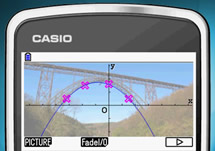
A new graphing calculator from Casio lets students plot mathematical equations on top of real-life images and user-uploaded photos—adding relevance to math concepts that many students find abstract and not applicable in the real world.
With conventional graphing calculators, students learn by inputting equations to create graphs. Casio’s PRIZM includes its proprietary Picture Plot technology, which lets users perform meaningful mathematical equations on top of real-life images such as Ferris wheels, jets from a water fountain, or building shapes. Students and teachers can upload images or photos to the calculator for further use, and photos are automatically formatted.
Colors can be added to a multitude of graphing objects, including dotted lines, circles, and bars, as well as grid lines on graphs, labels of coordinate axes, and coordinate values displayed during tracing. The Color Link function links the colors used in graphs to the designated values in the spreadsheet screen, to help students visually comprehend trends and changes in values. PRIZM also automatically color-codes brackets when entering equations with multiple brackets, as a visual aid to facilitate the entry of complex equations.
For more news about math and science instruction, see:
$3M gaming project could help spark STEM education
The PRIZM’s graphical natural display applies color to the screen and represents graphs, relations, and functions in true-to-life form. The full-color screen and operating system let students format data as they would in a computer-based spreadsheet application.
The PRIZM presents competition for Texas Instruments’ family of graphing calculators, including the TI-Nspire calculators, although the PRIZM does not have a computer algebra system (CAS), which is used to manipulate different variables in advanced mathematics functions such as those performed in calculus.
On Aug. 22, Casio announced a partnership with Steve Wolf—a stunt scientist, author, and producer—that aims to foster a student-centered learning environment for math and science instruction through the use of ed-tech tools.
Through this partnership, Wolf will demonstrate how movie stunts can help students gain a better understanding of math and science. Wolf now serves as a Science Advisory Teacher and uses Casio’s educational technology, specifically the PRIZM, during science conferences and one-hour school presentations, which he calls Science in the Movies.
Wolf uses math and science every day to solve the challenges of creating exciting movie effects. With Science in the Movies, Wolf highlights the essential role of math and science in the making of movie stunts and special effects. This gives students a unique opportunity for cross-curricular learning and for developing skills that can be used in all walks of life.
“I’m thrilled and grateful to be able to share the math and science behind movie stunts with kids. Stunts are one of the best ways to show kids how STEM is exciting, and Casio’s generosity and calculators make that possible,” said Wolf. “Casio is meaningfully supporting the comeback of math and science education in the United States, and that means a great deal to me.”
“We are honored to have someone of Steve Wolf’s caliber partner with Casio to help bring science and math to life beyond the classroom,” said Andrew Zweig, general manager of Casio’s Consumer Products Division. “We hope to spark students’ interest in math and science by working with Wolf to show students the electrifying connection between these subjects, movie stunts, and special effects.”
“The key to improving is understanding what you’ve done, and building on that knowledge,” said Wolf. “The ability to import video into the Casio PRIZM, and then run a detailed analysis of movement, has allowed my stunt team to understand complex movements, and that’s made our work much safer.”
For more news about math and science instruction, see:
$3M gaming project could help spark STEM education
- ‘Buyer’s remorse’ dogging Common Core rollout - October 30, 2014
- Calif. law targets social media monitoring of students - October 2, 2014
- Elementary world language instruction - September 25, 2014

